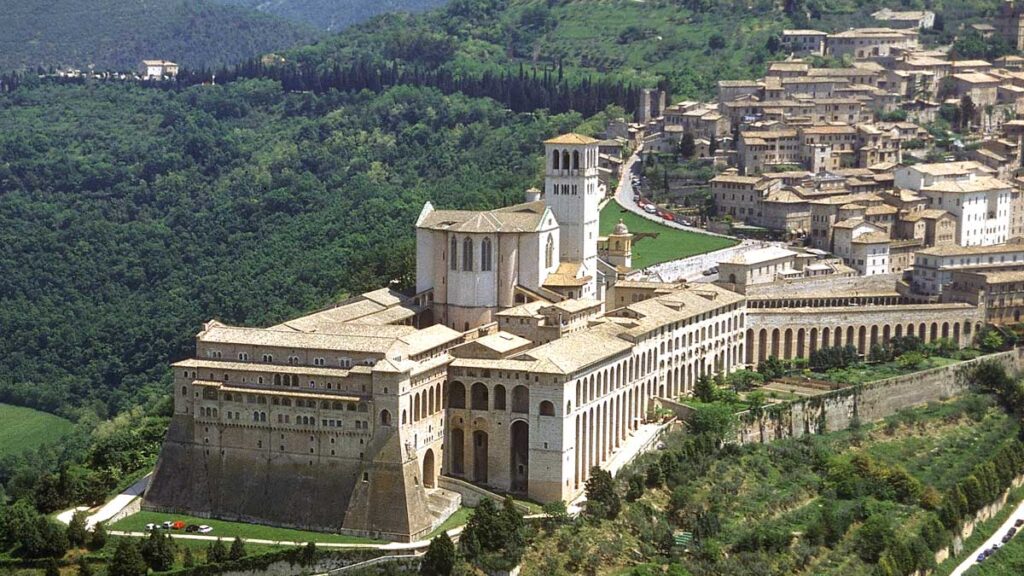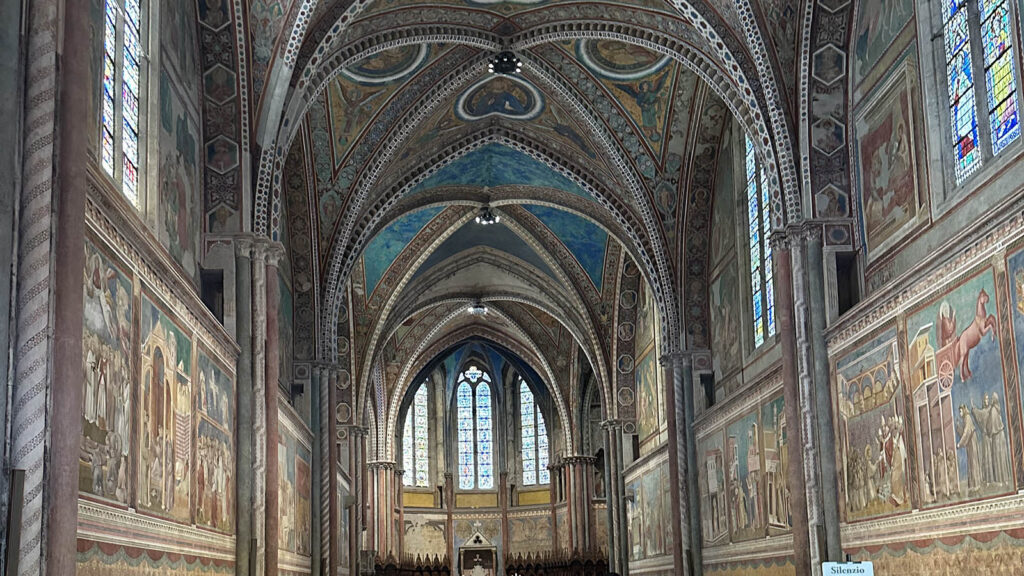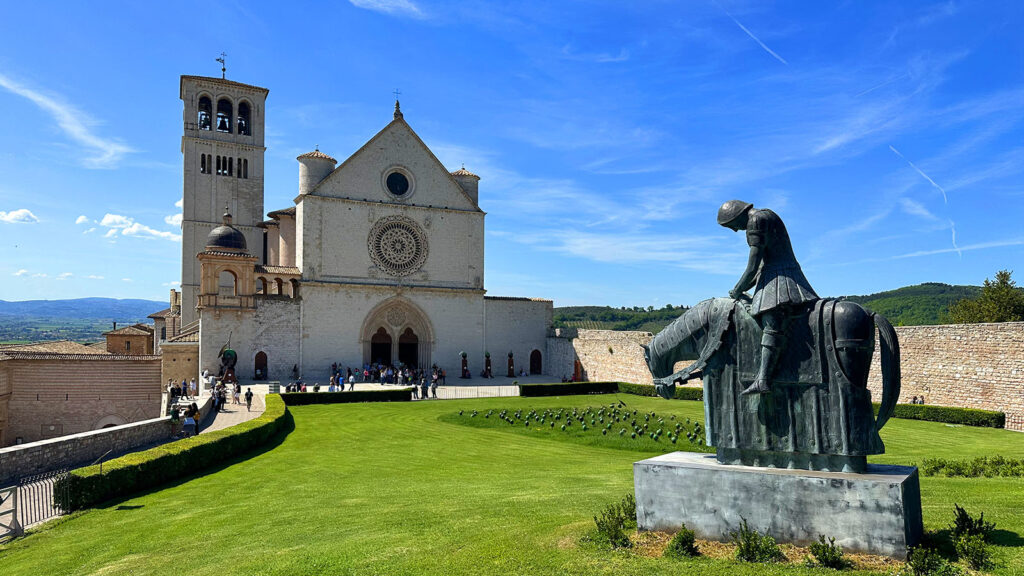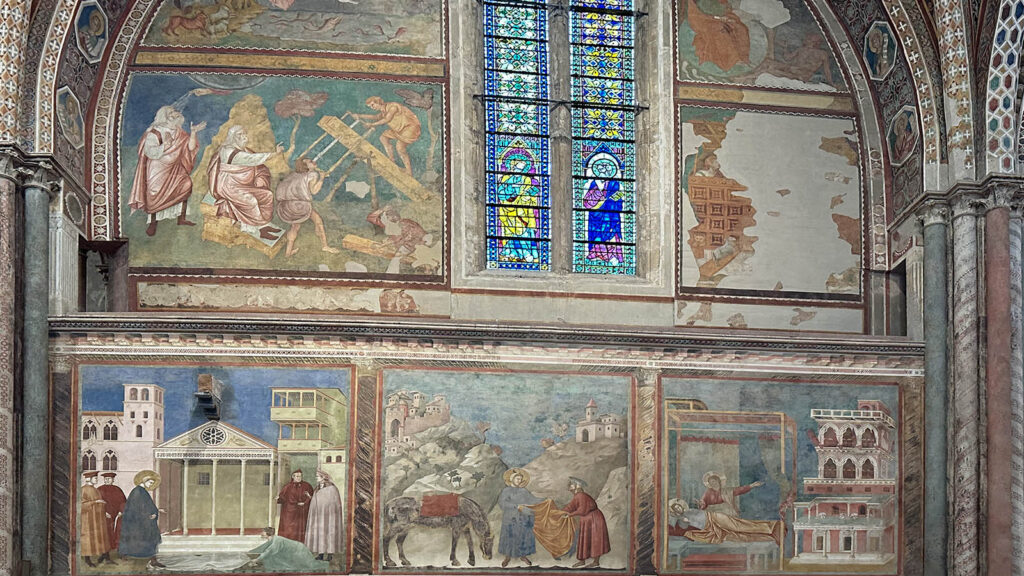
Assisi: one of the most important UNESCO’s heritage
Origins and history
Assisi is a small city-jewel, located at an altitude of 424 meters on the western hillside of the Mount Subasio.
This is the place where San Francesco (1182-1226) and Santa Chiara (1194-1253) were born, lived and died.
On this site, the Umbrians founded a small village around the 9th century BC. From the study of the archaeological finds found, they traded with the Etruscans who lived on the western side of the Tiber river.
In the 4th century BC, the Romans gave life to the Asisium colony, which, during the Roman Empire, became one of the largest economical and social centers.
Its story is told by the great buildings that survived from that period, such as the Amphitheater, the Walls, the Forum and the Temple of Minerva.
Once the Roman Empire fell, in 545, Assisi was occupied by the Goths and later by the Longobards.
Towards the year 1000, having become a free and autonomous municipality, it went through a period of extraordinary development, due to the arrival, as well as certain monastic orders, in particular of the Benedictine Order.
Francesco was born in 1182 and he was proclaimed Saint by Pope Gregory IX, in 1228, two years after the date of his death; on June 18, 1939, Pope Pius XII proclaimed Saint Francis of Assisi, the Saint of Italy.
The years between 1200 and 1500 continued under the Viscontis, the Montefeltros, the Sforzas and around the middle of the 1500s Umbria was conquered by Pope Paul III, to whom the construction of the imposing Rocca Paolina in Perugia dates back.
The arrival of the Napoleonic troops, between the end of the 1700s and the beginning of the 1800s, brought the city into a situation of poverty: all the treasures in the churches and many artworks were stolen.
In that period, Assisi had no commercial and industrial activities, was completely depopulated, because of the citizens were gone in the countryside to carry on the only possible activity, that is agriculture.
Structure and charm
Assisi is a medieval town and has been a UNESCO World Heritage Site since 2000.
The central and oldest part of the city is surrounded by a stout and well-preserved wall along which the Rocca Maggiore and the Rocca Minore are connected.
Eight are the fortified access gates.
Entering through one of these doors, one is immediately surrounded by the Middle Age. Every corner tells a story; you find yourself imagining the life at that time, with the swarming of its citizens among the economic activities of the most prosperous periods.
This is a place full of charm, the charm of the simplicity of the buildings, of the narrow streets, surrounded by flowers and small businesses.
Assisi is wonderful in all seasons:
- in winter, with the sober decorations, the crib exhibition, the many initiatives of the period and, if you are lucky enough to see it covered in snow, the white roofs that remind us of the beautiful paintings by Maestro Norberto, who became famous in world for having told – with his art – scenes of the daily life of the Franciscan friars;
- in spring, when nature explodes with its colors and flowers and the views from above give the tourist a unique and clear image;
- in summer, the refrigerator of its narrow streets allows you to enjoy many glimpses and the particular light offers magical pictures;
- autumn might seem a less beautiful period, but savoring the town in this period, perhaps on a foggy day, allows the pilgrim to have a dialogue with himself, far from the stress of today’s world, immersing himself in that mystical halo that envelops.
Architectural buildings
The Basilica of San Francesco
The Basilica is a spectacular building of the classic Italian Gothic style, whose construction began in 1228 and ended in 1280.
The frescos present there were made by the greatest artists of the 1300s: Giotto, Cimabue and Martini.
The Basilica complex was built with the typical pink stone of Subasio and consists of two superimposed churches: the Upper Basilica and the Lower Basilica.
Both of them have a cruciform plants and a nave of monumental dimensions.

Lower Basilica
The strength of the walls and of the lower structure – typical of the Romanesque style – have a load-bearing function, capable of supporting the upper church. The pointed arches – typical elements of the Gothic – are quite low, supported by squat and massive pillars.
The environment is rather dark, since natural light only penetrates through small cracks.
This is where the liturgical celebrations take place.
About in the halfway of the central nave, a staircase leads down to the crypt, where the remains of San Francesco, and other relics that belonged to him, are kept in a sarcophagus resting on the living rock. The simplicity of the place symbolically recall what the Saint’s life was.
A mystical place, where pilgrims pray.
Upper Basilica
In the upper church, the Gothic style is evident: the architectural structure develops in height and natural light enters forcefully from the large mullioned windows, decorated with polychrome stained glass.
This is the space for community prayer and official meetings of the order.
A cycle of frescoes in the upper portion of the nave, represents the New and Old Testaments and it is interspersed with beautiful medieval stained glass windows.
In the lower half of the nave stands the pictorial cycle, attributed to Giotto, “Stories of San Francesco“: twenty-eight scenes that narrate the most important moments in the life of Francesco.

The facade
The Upper Basilica has a facade in the shape of a hut in the Romanesque-Umbrian style.
It has a remarkable vertical development, rebalanced by the presence of two frames which divide it into three horizontal bands.
In each bands, starting from the bottom, take place:
- the mullioned window portal;
- the beautiful decorated front window;
- the tympanum.

Other places not to be missed
After the visit to the Basilica, walking along the small and characteristic alleys, you find the Piazza del Comune.
Here the Temple of Minerva, the Palazzo del Capitano del Popolo, the Torre del Popolo and the Palazzo dei Priori provide a beautiful glance.
Continuing along a street full of shops, pastry shops and restaurants, on our right we will find a small arch, which once passed will take us to the birthplace of San Francesco.
At the end of this street, the square will open up where the Basilica of Santa Chiara stands, in Gothic style, built between 1257 and 1265.
Inside take place frescoes of the Umbrian school of the thirteenth and fourteenth centuries and the beautiful wooden Crucifix which, according to tradition, spoke to San Francesco.
In the crypt a sarcophagus houses the relics of Santa Chiara.
On leaving, on the left, the beautiful view over the Umbrian valley, with its colors and hills as far as the eye can see, where the Basilica of Santa Maria degli Angeli stands out, within which the Porziuncola is enclosed.
While San Francesco was praying to the Crucifix of San Damiano, he heard a voice saying: “Go and repair my church”.
After his vocation, the Porziuncola was the third church repaired by San Francesco (after the Church of San Damiano and the Church of San Pietro della Spina in Rivotorto).
San Francesco was very close to this place, so much so that here he often stopped to pray, realizing that he had to live according to the Holy Gospel, and always here he invited the first friars to spread the message of peace.
The Porziuncola also welcomed Santa Chiara when she fled from her family to convert and embrace Sister Poverty.
In 1205 San Francesco founded the Franciscan Order there, while in 1211 Santa Chiara also received the religious habit from the Saint, founding the first female monastic order, that of the Poor Clares.
Not everyone knows an underground Assisi, which is absolutely worth visiting by referring to this site:
https://www.umbriasotterranea.it/assisi/
Assisi, city of Saints
San Francesco (Saint Francis)
Francesco was born to Giovanna Pica and Pietro di Bernardone, a rich merchant of fabrics, eager for his son to continue his commercial activity.
His expectations of him were disappointed, first of all, when Francesco embarked on a military career, participating in numerous battles: in 1202, in the clash between Perugia and Assisi, he was taken prisoner in Perugia for a year.
Once back home, he fell ill and, during his convalescence, he walked in nature admiring its beauty and prayed. His dream, however, was still to become a knight and, with this in mind, he left for Puglia to support the leader Gualtiero di Brienne, but near Spoleto he was stopped by the voice of the Lord, who invited him to return to Assisi and wait for new indications.
Once in Foligno, in the central square, he sold his horse and his rich clothes, to wear some very modest ones: this was his choice of poverty. He visited the prisoners, the hospitals, he helped the poors and in them he saw the image of Christ.
He began to be followed by the first fratres: they wore rags, walked barefoot, slept in makeshift places and over time assumed the name of “minor friars”; their mission was to renovate the abandoned and ruined churches and devote themselves to the care of lepers: for this reason, they were avoided by everyone for fear that the disease could infect them.
In the following years they preached addressing the people of central Italy and inviting them to penance; since, however, the preaching of the laity was prohibited by the Church, they tried to obtain, in 1210, their identification by presenting their own Rule of life based on evangelical poverty to Pope Innocent III.
The Pontiff approved it and, in 1223, with Pope Honorius III , the Franciscan Order was officially born.
They preached love, peace, forgiveness, faith, brotherhood and helped the farmers in the fields, receiving only food in exchange, while in the evening, in the hermitages, they were nourished by the power of the Gospel.
The work of evangelization went beyond Umbria and Lazio, touching Tuscany, the Marches, Emilia, the Veneto, Lombardy and even France and Spain.
In the last part of his life, Francesco was struck by a serious stomach disease, which prevented him from eating.
The friars took him first to San Damiano and then to his beloved Porziuncola where he died in the night of October 3, 1226 saying “Welcome, Sister Death… Here is the Lord calling me”.
He was buried definitively in the Basilica dedicated to him.

Santa Chiara (Saint Clare)
Chiara Offreduzzo was born in Assisi in 1193 to Messer Favarone di Offreduzzo degli Scifi and Madonna Ortolana Fiumi, both nobles.
Unfortunately, her father died and her mother was left alone in Assisi to take care of Chiara, together with her three sisters; although her mother had noble origins, life for a family made up of five females in the 1200s was not easy at all.
In this period, for girls at a very young age, the choice could be either monastic life or marriage.
An arranged marriage had been planned for Chiara, but she didn’t want to marry a man she didn’t know.
She was only 12 years old when Francesco stripped of his possessions to embrace Poverty.
Seven years later she runs away from her home and joins Francesco at the Porziuncola: he cuts her hair and invites her to wear the Franciscan dress.
Chiara opposed the requests of her father who tries to bring her back to the family and takes refuge in the Church of San Damiano, where she founds the female order of “poor recluses” (the Poor Clares).
Chiara was appointed Abbess and Francesco took care of drafting the first Rule, which Chiara later made definitive, obtaining from Pope Gregory IX the “privilege of poverty”, i.e. the concession to the sisters to live in full poverty and that they could not be forced by anyone to accept other people’s goods.
Santa Chiara lived in this place for over forty years, with about fifty women.
Chiara was always faithful, without ever yielding, to the teachings of San Francesco.
On August 11, 1253 she died and two years later she was canonized.
Francis and Clare, a spiritual relationship
The relationship between Clare and Francis was based – as Goethe said – on “an elective affinity”, in other words when two people who choose each other and make the same choice.
Between them there was a form of confidentiality, which led them to speak little and theirs was a true spiritual love.
Francis called Clare his “little plant” and Clare called Francis “our Father”; theirs was a profound understanding, because based on a communion of intentions, they looked in the same direction, guided by the Gospel.
If you are lucky and leave the mystical Assisi at sunset, you mustn’t forget to turn around and take a few minutes to admire the imposing Basilica of San Francesco, Santa Chiara’s Church, the bell towers, the fortress that overlooks everything, the many pink stone houses of Subasio, which with the setting of the sun takes on such an intense color that it leads to a real emotion of the soul for so much beauty.